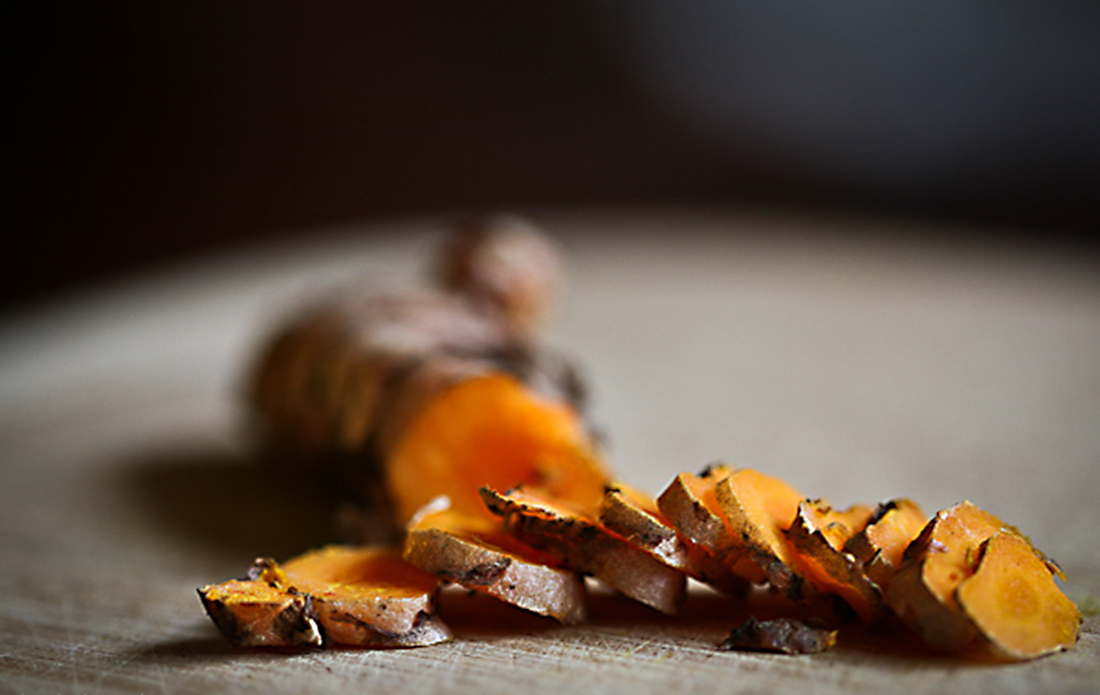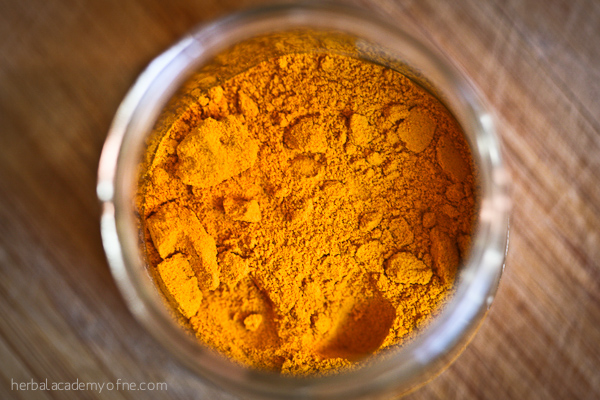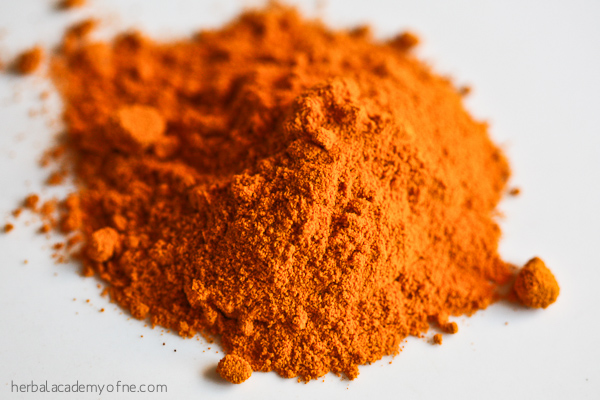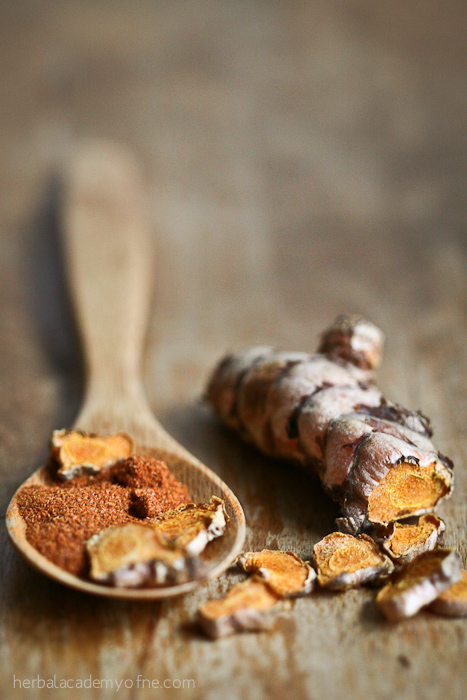
Turmeric Health Benefits: The Golden Goddess
Most of us know turmeric (Curcuma longa) as the vibrant orange powder located in the spice section between thyme and vanilla beans. And many of us use turmeric root powder in our cooking, particularly if we have an affinity for preparing Indian-inspired dishes. Similar to the root-like component of its cousin ginger, turmeric has been a staple of Indian food traditions for millennia and has a long history of healing use (over 4000 years) in Ayurvedic, Traditional Chinese, and Siddhic medicinal traditions.
Turmeric’s role in Hindu devotional and sacred ceremonies is alluded to by one of its Sanskrit names: Kanchani, the “Golden Goddess,” perhaps so called because its beautiful golden hue generously bestows healing to a wide range of ailments (Gallant, n.d.).

Indeed, traditional Ayurvedic use includes turmeric as healing agent for skin abrasions, GI tract inflammation, aches and pains, and liver disorders, while modern research confirms the anti-bacterial, anti-inflammatory, and antioxidant properties of turmeric.

The characteristic golden hue is produced by curcumin, the constituent in turmeric most isolated and studied by scientists, but the whole herb is used in herbal traditions and has also been the subject of many favorable studies.
Turmeric’s Herbal Actions
Antioxidant and Anti-Inflammatory
Antioxidants scavenge free radicals and help to reduce or prevent damage and inflammation caused by free radicals, and anti-inflammatory agents block enzymes that promote inflammation and pain. Turmeric is often used in an Ayurvedic approach to reduce inflammation of the throat and tonsils, and as an anti-inflammatory herb for many other aches and pains. A randomized 2009 study examined the efficacy and safety of turmeric in patients with knee arthritis (an inflammatory condition), concluding that turmeric was as effective and as safe as ibuprofen (Kuptniratsaikul et al., 2009). You will find that a number of culinary herbs also have antioxidant and anti-inflammatory properties, including sage, ginger, and garlic.
Antimicrobial
Antimicrobial herbs inhibit the growth of pathogens like bacteria, viruses, and fungi. A 2009 study on aqueous extract of turmeric showed good antimicrobial action against such pathogens as Escherichia coli and Staphylococcus aureus (Niamsa et al., 2009).
Cholerectic
Cholerectics stimulate production of bile, thereby supporting digestion. In Ayurveda, turmeric is a warming herb that kindles digestive fire, or agni. Like other bitter-flavored herbs that stimulate bile production, turmeric is used to promote digestion and alleviate symptoms in the GI tract. A randomized, double-blind crossover study in 1999 used ultrasound to examine the gallbladder after administration of curcumin, leading researchers to conclude that “curcumin induces contraction of the human gall-bladder” (Raysid et al., 1999).
In a double-blind, placebo controlled study in Thailand, curcumin was compared to placebo and an over-the-counter remedy for indigestion. Eighty-seven percent of the curcumin group had full or partial relief from indigestion after 7 days, compared to 53% of the placebo group (Thamlikitkul et al., 1989).

Turmeric offers such a dynamic array of health benefits that it’s even being studied in regards to its potential effect on serious diseases like cancer, Alzheimer’s, and heart disease. Cardiac specific benefits are its effects on cholesterol, triglycerides, and blood sugar. While studies do not show that it would be a good substitute for cholesterol and diabetes medications, long-term use may help reduce the amount of other medications used in a treatment level.
How to Use Turmeric
Topical and External Use
Because of its antibacterial properties, when combined with a little salt and mixed together as a paste, turmeric can be applied to the skin in response to abrasions and swelling. This remedy is also used to help resolve bruises. Gargling with salt water is often thought to help relieve a sore throat. But turmeric, when paired with salt, has the potential to be even more effective! You can find turmeric at this link or at your local grocery store.
Gargle With Turmeric and Salt
A pinch or two of turmeric
A pinch or two of salt
Add to warm water and gargle as you would regular salt water.
Internal Use
The medicinal properties of turmeric may not be absorbed well due to its rapid metabolism in the liver and intestines unless it is consumed with black pepper. In a validating example of the time-tested concept of herbal catalysts (herbs that enhance the activity of other herbs), it turns out that the piperine in black pepper enhances the bioavailability of the curcumin in turmeric by 2000% (Shoba et al., 1998)! Note: black pepper may inhibit drug metabolism so should be used with caution, if at all, by those taking pharmaceutical medications.
Whether by incorporating it into cooking or taking it as one of several herbs in a tea, turmeric is at the heart of many different remedies and continues to prove its value after thousands of years of use.
One such tried and true recipe is “Golden Milk,” a traditional Ayurvedic concoction. Here is our take on this age-old recipe, with the addition of black pepper for enhanced curcumin bioavailability. This yummy, warming drink is delicious in the winter and can be served room temperature or slightly warmed if desired.

Turmeric Recipes
Traditional instructions recommend making a turmeric paste first, which can be spread on toast or added to other dishes, but you can also simply add turmeric powder into the milk.
Turmeric Paste
¼ cup ground turmeric
½ cup water
- Combine turmeric powder and water in a saucepan.
- Simmer until mixture forms a thick paste.
- Let cool, then store in fridge.

Golden Milk
Serves one
1 cup unsweetened coconut, rice, or almond milk
¼ – 1/2 teaspoon turmeric paste (or just add powder)
1 teaspoon coconut oil
Few shakes of ground black pepper
Generous dash of vanilla
Raw local honey or maple syrup to taste
Sprinkle of cinnamon
- Place 1 cup milk with turmeric paste, oil, black pepper, vanilla, and honey/maple syrup into a blender.
- Blend on high briefly until combined and foamy.
- Pour into cup, sprinkle with cinnamon, and serve.
Safety
Turmeric eaten in food is considered safe.
For some individuals, turmeric should not be used at high doses long term (Mills & Bone, 2005), as overuse may cause gastrointestinal disturbances (e.g., diarrhea, nausea, ulcers) in some susceptible people (McIntyre, 2005; Ehrlich 2014). Turmeric is considered contraindicated in the case of biliary tract obstruction due to potential bile-stimulating activity, and those with a history of biliary tract obstruction should gain professional advice before using turmeric at therapeutic doses (Mills & Bone, 2005; Gardner & McGuffin, 2013).
Because turmeric may have antiplatelet and blood-thinning activity, individuals on blood-thinning medications should exercise caution when considering therapeutic use and speak with their healthcare professional or pharmacist prior to self-administration (Mills & Bone, 2005). For similar reasons, it is also generally advised that individuals undergoing surgery stop consuming therapeutic doses of turmeric at least two weeks prior to their procedure (Ehrlich, 2014).
Eating foods with turmeric during pregnancy is generally considered safe, however turmeric should not be taken in high doses by pregnant women due to its potential emmenagogic effects (McIntyre, 2005; Ehrlich, 2014).
Lastly, one small study concluded that consumption of supplemental doses of turmeric can significantly increase urinary oxalate excretion which may subsequently increase risk of kidney stone formation in susceptible individuals (Tang et al., 2008).
Learn more about turmeric and other herbs in the Online Intermediate Herbal Course, featuring over 100 recipes for health and wellness.
REFERENCES
Baum, L., Lam, C. W., Cheung, S. K., Kwok, T., Lui, V., Tsoh, J., . . . Mok, V. (2008). Six-Month Randomized, Placebo-Controlled, Double-Blind, Pilot Clinical Trial of Curcumin in Patients With Alzheimer Disease. Journal of Clinical Psychopharmacology, 28(1), 110-113. doi:10.1097/jcp.0b013e318160862c
Ehrlich, S.D. (2014). Turmeric. Retrieved from http://www.umm.edu/health/medical/altmed/herb/turmeric
Frawley, D. and Lad, V. (2001). The yoga of herbs. Twin Lakes, WI: Lotus Press.
Gallant, Lisa. (n.d.). Turmeric: “The Golden Goddess.” California College of Ayurveda. Retrieved from http://www.ayurvedacollege.com/articles/students/turmeric
Gardner, Z. & McGuffin, M. (2013). American Herbal Product Association’s herbal safety handbook. New York: CRC Press.
Kuptniratsaikul, V., Thanakhumtorn, S., Chinswangwatanakul, P., Wattanamongkonsil, L., Thamlikitkul, V. (2009). Efficacy and safety of Curcuma domestica extracts in patients with knee osteoarthritis. The Journal of Alternative and Complementary Medicine,15(8): 891-897. https://doi.org/10.1089/acm.2008.0186
Liu, K., Zhang, D., Chojnacki, J., Du, Y., Fu, H., Grant, S., & Zhang, S. (2013). Design and biological characterization of hybrid compounds of curcumin and thalidomide for multiple myeloma. Organic & Biomolecular Chemistry, 11(29), 4757. doi:10.1039/c3ob40595h
Lad, Vasant. (1984) Ayurveda. Twin Lakes, WI: Lotus Press.
McIntyre, A. (2005). Herbal treatment of children: Western and ayurvedic perspectives. Edinburgh: Elsevier Butterworth Heinemann
Mills, S. & Bone, K. (2005). The essential guide to herbal safety. St. Louis, MO: Elsevier Churchill Livingstone.
Niamsa, N and Sittiwet C. (2009). Antimicrobial Activity of Curcuma longa Aqueous Extract. Journal of Pharmacology and Toxicology, 4: 173-17
Rasyid, A., Lelo, A. The effect of curcumin and placebo on human gall-bladder function: an ultrasound study. (1999) Alimentary Pharmacololgy and Therapeutics, 13:245-249.
Shoba, G., Joy, D., Joseph, T., Majeed, M., Rajendran, R., Srinivas, P.S. (1998). Influence of piperine on the pharmacokinetics of curcumin in animals and human volunteers. Planta Medica, 64 (4): 353–6.
Tang, M., Larson-Meyer, D.E., & Liebman, M. (2008). Effect of cinnamon and turmeric on urinary oxalate excretion, plasma lipids, and plasma glucose in healthy subjects. American Journal of Clinical Nutrition, 87 (5): 1262-1267.
Thamlikitkul, V., Bunyapraphatsara, N., Dechatiwongse, T., Theerapong, S., Chantrakul, C., Thanaveerasuwan, T., . . . Gingsungneon, V. (1989). Randomized double blind study of Curcuma domestica Val . for dyspepsia. Journal of the Medical Association of Thailand, 72:613-620.








